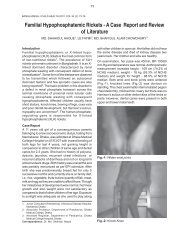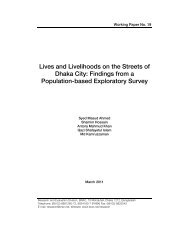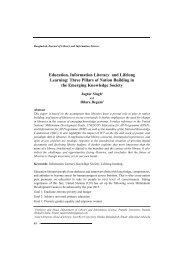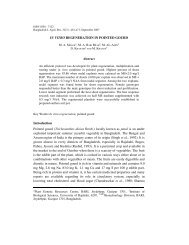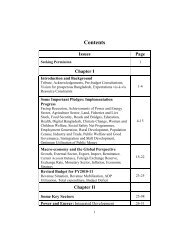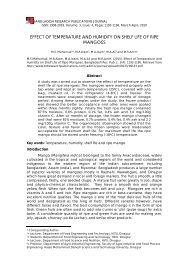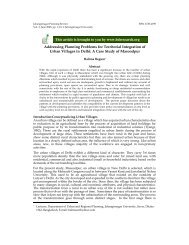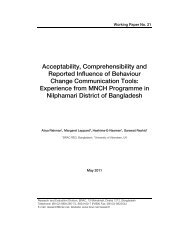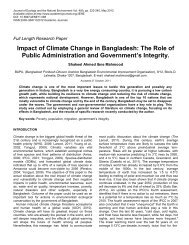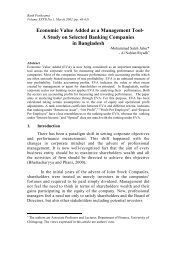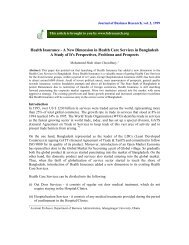Studies on Policy Option for Quality Seed Production and ... - NFPCSP
Studies on Policy Option for Quality Seed Production and ... - NFPCSP
Studies on Policy Option for Quality Seed Production and ... - NFPCSP
Create successful ePaper yourself
Turn your PDF publications into a flip-book with our unique Google optimized e-Paper software.
EXECUTIVE SUMMARYSTUDIES ON POLICY OPTION FOR QUALITY SEED PRODUCTION ANDPRESERVATION OF CEREAL CROPS AT FARMERS’ LEVEL FOR THEIMPROVEMENT OF FOOD SECURITY<strong>Seed</strong> is the foundati<strong>on</strong> of agriculture <strong>for</strong> enhancing crop producti<strong>on</strong>. But the availability of qualityseed is the main c<strong>on</strong>straint to crop producti<strong>on</strong> in Bangladesh. The use of quality seed can c<strong>on</strong>tributesignificantly to increase grain yield as well as to increase the availability of every day’s food intake.The producti<strong>on</strong> of quality seed is thus very important <strong>and</strong> that’s why the government has recentlygiven the seed sector a `Topmost Priority’ status. There<strong>for</strong>e, the main objective of this project is toinvestigate the c<strong>on</strong>straints related to availability of quality seeds <strong>for</strong> producti<strong>on</strong> of cereal crops, assesspost harvest losses <strong>and</strong> determine the quality of farmers’ homegrown seeds <strong>and</strong> develop policyopti<strong>on</strong>s <strong>for</strong> quality seed producti<strong>on</strong> at farmers’ level <strong>for</strong> increasing crop yield <strong>and</strong> producti<strong>on</strong> towardsattaining food security.The present study was involved with three major cereal crops viz., rice, wheat <strong>and</strong> maize. The studylocati<strong>on</strong>s were Rajshahi, Rangpur <strong>and</strong> Jessore (<strong>for</strong> rice); Rajshahi, Dinajpur <strong>and</strong> Rangpur (<strong>for</strong> wheat);<strong>and</strong> Rajshahi, Dinajpur <strong>and</strong> Kishoreg<strong>on</strong>j (<strong>for</strong> maize). In this regard, three categories of sample farmersviz., large (la nd occupati<strong>on</strong> of ≥5.01 ac), medium ( 2.01-5.00 ac) <strong>and</strong> small (0.51 -2.00 ac) werer<strong>and</strong>omly selected <strong>for</strong> <strong>for</strong>mal survey. Data were collected through PRA, FGD, pers<strong>on</strong>al interview <strong>and</strong>different types of survey questi<strong>on</strong>naires. Besides, the farmers’ homegrown seed of rice <strong>and</strong> wheatwere collected <strong>and</strong> analyzed in the laboratory <strong>for</strong> determining seed quality. It is menti<strong>on</strong>ed that asalmost all the farmers use hybrid seed <strong>for</strong> maize producti<strong>on</strong> in the survey area, the seed quality ofmaize was not determined thereof. The collected data were compiled <strong>and</strong> analyzed through theappropriate computer software <strong>for</strong> report writing.The results revealed that the farmers all over the study locati<strong>on</strong>s use 70-80% of rice seed, <strong>and</strong> 50-60%of the wheat seed from their homegrown grain crops. The major outer-suppliers of rice (20-30%) <strong>and</strong>wheat (40 -50%) seeds to farmers are BADC, DAE, <strong>Seed</strong> Dealers, NGOs etc. On the other h<strong>and</strong>,almost all the farmers fully depend <strong>on</strong> <strong>Seed</strong> Dealer/<strong>Seed</strong> Company as the sources of their hybridmaize seeds. The farmers’ homegrown rice <strong>and</strong> wheat seeds had low yielding ability compared to theseeds provided by BADC/Research organizati<strong>on</strong>s (increase <strong>on</strong> average 22.0% <strong>and</strong> 23.5% of rice <strong>and</strong>wheat yields, respectively compared to homegrown seed). Farmers sometimes receive TruthfullyLabeled <strong>Seed</strong> (TLS) from the seed dealers <strong>and</strong> seed companies. But the realiability of the TLS is oftensubject to questi<strong>on</strong> <strong>and</strong> farmers are sometimes deceived by using TLS as some sort of ill practice arereported to be there.The farmers traditi<strong>on</strong>ally use Katcha floors <strong>for</strong> grain/seed drying (80% <strong>and</strong> 66% <strong>for</strong> rice <strong>and</strong> wheat,respectively), as they d<strong>on</strong>’t have Pucca floors; but the moisture c<strong>on</strong>tent of cereal seeds cannot beattained below 12% by using the Katcha floor, because the seeds during the drying process absorbiii



